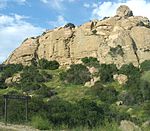Santa Susana Pass State Historic Park

Santa Susana Pass State Historic Park is a California State Park of 670.68 acres (2.7141 km2) located in the city of Los Angeles, in Los Angeles County on the boundary between Ventura and Los Angeles counties, between the communities of Chatsworth and Simi Valley. Geologically, the park is located where the Simi Hills meet the Santa Susana Mountains. Here in the western part of the Transverse Ranges, the land is dominated by high, narrow ridges and deep canyons covered with an abundant variety of plant life. The park offers panoramic views of the rugged natural landscape as a striking contrast to the developed communities nearby. The park is also rich in archaeological, historical, and cultural significance.
Excerpt from the Wikipedia article Santa Susana Pass State Historic Park (License: CC BY-SA 3.0, Authors, Images).Santa Susana Pass State Historic Park
Bannon Quarry Trail, Los Angeles
Geographical coordinates (GPS) Address Nearby Places Show on map
Geographical coordinates (GPS)
| Latitude | Longitude |
|---|---|
| N 34.256666666667 ° | E -118.62055555556 ° |
Address
Bannon Quarry Trail
Bannon Quarry Trail
91311 Los Angeles
California, United States
Open on Google Maps







